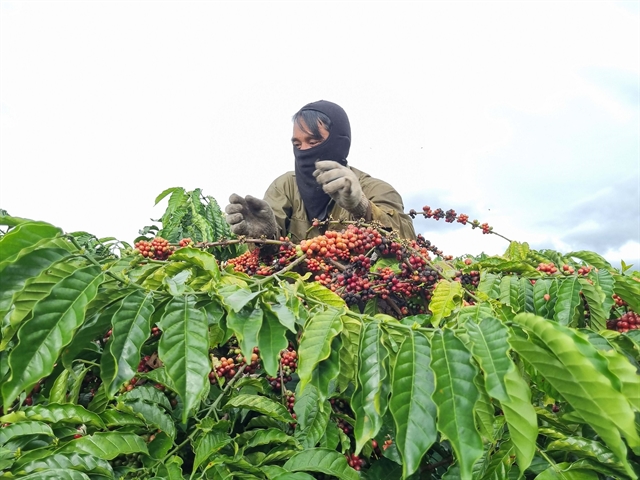 Economy
Economy


|
| A farmer in Gia Lai Province is harvesting coffee. The prices of Vietnamese coffee are forecast to continue to increase on supply shortage next year. — VNA/VNS Photo Hồng Điệp |
HÀ NỘI — The prices of Vietnamese coffee are forecast to continue to increase next year due to severe supply shortage, according to the Vietnam Coffee Cocoa Association (Vicofa)
Domestic prices on Monday temporarily moved sideways after a series of increases last week to record levels. Never has Việt Nam experienced such a shortage of coffee.
Coffee prices were around VNĐ67,200 – 68,000 per kilogram in Tây Nguyên (Central Highlands) Lâm Đồng, Đắk Lắk and Đắk Nông, about VNĐ900 -1,000 per kg higher than last week and VNĐ8,000 than early December.
According to Mercantile Exchange of Việt Nam, for the week ending Sunday, coffee prices increased by 1.85 per cent for Arabica and 0.42 per cent for Robusta.
Farmers are delaying their sales with expectations of higher prices.
Despite being good news to farmers, high coffee prices push export enterprises into a lot of difficulty in collecting enough coffee for their signed contracts.
Đỗ Hà Nam, Vicofa’s Deputy President, said that unpredictable coffee price fluctuations caused difficulties in exporting. In the 2022-23 crops, several domestic exporters could not deliver in time because of rising prices, partly as an impact of hoarding. “During the past three decades, never have we thought that Việt Nam could be in a shortage of coffee,” Nam said.
The association has estimated that the coffee shortage of signed contracts is around 80,000 – 150,000 tonnes, waiting for the coming harvest season to be fulfilled.
Việt Nam exported more than 120,000 tonnes of coffee in November, half of which was to make up for the shortage of orders of the previous harvest crop, he said.
Coffee prices are forecast to be around VNĐ60,000 – 70,000 per kg in the coming months and are expected to decrease when Indonesia and Brazil start new coffee harvest seasons in April and May.
In the new crop, the asking prices of green coffee reached VNĐ60,000 per kg for delivery in December 2023 and January 2024 – an unprecedented price recorded at the beginning of harvest season due to high purchasing demand from export enterprises who are worried that there would be no coffee to buy from April or May next year. In 2023, coffee was out of stock from June.
According to Vicofa the European markets are the largest market for Vietnamese coffee, which consume around 40-50 per cent of the country’s exports and still have good demand for coffee.
“There will be tension in coffee supply sources. Việt Nam’s green coffee prices will continue to increase in 2024 and is poised for a record export revenue of $5 billion,” Nam said. This, however, causes a problem – enterprises are hoarding, which will bring significant risks.
A report about the coffee market by the US Department of Agriculture (USDA) issued last week showed that the global coffee inventory was estimated at 26.5 million 60-kg bags, 16.7 per cent lower than the previous estimate and the lowest inventory level in the past 12 years.
USDA forecasts that world coffee production for 2023-24 will reach 171.4 million bags, 6.9 million bags higher than the previous crop.
Việt Nam production is forecast to add 300,000 bags to reach 27.5 million. The cultivated area is forecasted to remain unchanged, with nearly 95 per cent of total output remaining as Robusta. However, with lower total supplies due to last year’s stock drawdown, bean exports are forecast to decline by 2.4 million bags to 23 million, according to the USDA’s report.
In the context of tense supply, Nam said that Việt Nam was focusing on solutions to promote the sustainable development of the coffee industry, including ensuring origin traceability and meeting the EU’s regulations on deforestation. — VNS




